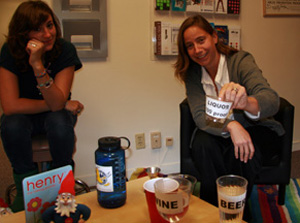Campus News
Party hardly: UCSC ramps up its campaign inviting students to think when they drink
Gnomeland Security: An irreverent UCSC alcohol awareness campaign aims at decreasing risk, not condemning students for partying.


The boozed-up co-ed lies unconscious near a pair of empty liquor bottles.
Lying with her head on a table, she has no idea that a ceramic gnome is staring at her with a forlorn look on its face.
This image appears on a poster advertising an alcohol awareness initiative sponsored by SHOP (Student Health Outreach and Prevention), a campaign headquartered at the Student Health Center and designed to make young drinkers aware of the risks they are taking.
The campaign, with the pint-sized gnome as its mascot, aims at decreasing risk, not condemning students for partying.
“We want to meet them where they are, provide education, and suggestions for reducing risks,’’ said Paul Willis, UCSC’s Alcohol and Other Drug (AOD) educator. “They are emerging adults. Outright prohibition doesn’t work.”
But what do gnomes have to do with it?
“For one thing, gnomes are small,” said Meg Kobe, interim coordinator of SHOP. Their diminutive stature helps SHOP spread the word that partiers should think small–a modest amount of partying, and a small amount of drinks–when they let loose for the weekend.
SHOP’s campaign uses gnome-themed door hangers, Beanie Baby-style plush gnomes, and gnome T-shirts, with an ever-changing list of puns: “Gnomeland Security” and “Chillin’ With My Gnomies,” among others.
SHOP placed a full-page ad in the Student Primer Issue of City On A Hill, and provides “Department of Gnomeland Security” brochures to police, who distribute them to students when they intervene at unruly off-campus parties. Members of the SHOP team also appeared at a recent round of off-campus neighborhood block parties.
The goofiness is a means to an end. Gnome pamphlets and brochures include disturbing inventories of alcohol poisoning symptoms and lists of emergency phone numbers. And while SHOP is not responsible for enforcing drug and alcohol policy, its awareness campaign coincides with campus and city police’s stepped-up enforcement in the first few weeks of the fall semester.
That enforcement and the gnome-related campaign are responses to a nationwide “college effect”–a reported spike in high-risk alcohol related incidents–that takes place during the first six weeks of school.
As part of its alcohol education program, UCSC also requires entering first-year students to complete a two- to three-hour alcohol awareness online course that includes three surveys and an exam.
SHOP recruits students to give an extra layer of credibility to the project. Anya Hunter, a student who works at SHOP as part of UCSC’s Chancellor’s Undergraduate Internship Program (CUIP), was sold on the non-scolding, pro-health positivity of the program.
Students start to run into trouble when they pound down drinks without thinking about how much they can handle, Hunter said.
When Hunter was out and about, talking about the “Gnome Project,” several students shared their reactions. “They love how the project is not telling them what they are doing is wrong but telling them to take extra precaution,” she said.
Kobe adds another degree of visibility by walking around the campus with a Gymboree bag crammed with simple, effective props that give students a better sense of how much liquor they are consuming.
“People will say, ‘I don’t know what happened. I only had three drinks,’” Kobe said. But she underscored the point that looks can be deceiving when she pulled out a “party cup”–one of those 16-ounce plastic red containers found at countless keg parties.
Kobe likes to remind students that a “serving” of beer is just 12 ounces, four ounces less than the beer a bartender serves in a pint glass, and that “one drink” of 100-proof liquor looks like a tiny dribble when poured into the bottom of a big red party cup.
Drinking that little puddle of liquor is like quaffing a whole beer, even though it barely comes up to the lowest line on the party cup.
“Some people say, ‘Well, I only had one glass, which means I only had one drink,’” Kobe said. “Well, if your goblet is the size of a fish tank, you could easily have the equivalent of 12 drinks.”
She alerts students to the hazards of self-styled ‘rules’ that are designed to keep students out of trouble with booze but don’t hold up to analysis.
“You can’t quantify it by saying ‘one drink an hour,’” Kobe said. The trouble with that philosophy is the fact that all people are different when it comes to liquor tolerance and size. “If it’s a very small female, one drink an hour could be dangerous.”
SHOP’s “Just Say Gnome … party small” alcohol awareness campaign is part of the Safer California Universities Project, a research project that tests the effectiveness of increased alcohol enforcement, increased visibility of enforcement, and working closely with college students.
For more information from SHOP about alcohol and other drugs, go to http://www2.ucsc.edu/healthcenter/shop/alcohol_and_your_body.shtml